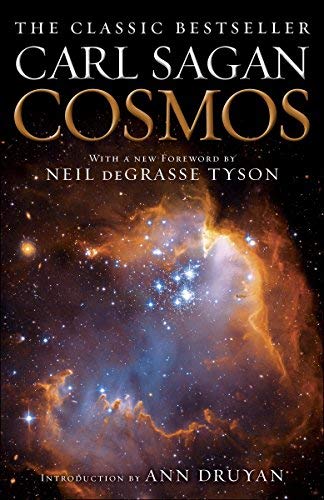Foreword: Cosmos
From Cosmos by Carl Sagan.
Appears in the 2013 reissue.
Not everyone who successfully impacts the hearts and minds of one generation will carry that currency of influence into the generations that follow. But the continued success of Cosmos, Carl Sagan’s magnum opus, argues strongly for Carl’s affability and intelligence. But it also reveals a hidden hunger in us all to learn about our place in the universe and embrace why it matters intellectually, culturally, and emotionally.
These properties distinguish the work of Carl Sagan and his collaborators from all other efforts to communicate science. Most good books in the genre teach you what to know in the author’s field of expertise—what’s hot, what’s interesting—in clear and simple language. But rarely is that information shaped into knowledge. And even more rarely is that knowledge shaped into wonder; the foundation of a cosmos perspective on the world. Dare I assert that Cosmos wielded this power in ways that profoundly influenced how we would observe, interpret, and conduct our lives.
One of the least noted facts about Cosmos, but perhaps the most significant of its gifts to human culture, is how it repeatedly cross-pollinated the traditional sciences—astronomy, biology, chemistry, and geology. When taken separately, these fields are each noble and time-honored. But when taken together—when Cosmos wove them into a tapestry of insight on our place in the universe—their juxtaposition became potent and indelible. Cosmos was early, if not first in this endeavor. In the decades that followed its publication, we would see the rise of hybrid fields of study such as astrobiology, astro-particle physics, astro-chemistry, planetary geology—some still donning their hyphens.
But the publication and best-selling success of Cosmos accomplished much more than this. The book’s treatment of scientific topics was persistently blended with other traditional fields of study, such as history, anthropology, art, and philosophy. Revealing for the first time how and why readers should embrace all the ways that science matters in our culture.
At the time, there was nothing fresher, more uplifting, or more empowering than the themes and messages of Cosmos. Perhaps for the first time in any medium, the person teaching you science—Carl Sagan—cared about the tangled mental roadways that can rob a person of rational thought. His motif was to speak with you, not lecture at you. With that level of pedagogical comfort, millions of people around the world invited his television image into their living rooms and his printed words into their reading chairs.
When Cosmos first arrived in 1980, the arms race of the Cold War was fading, but nonetheless continued to hold hostage the world’s nations with a nuclear arsenal of destructive powers derived from the minds of physicists. But exploration was not without hope. NASA had already landed Viking on Mars, seven years after we walked on Moon. And the twin Voyager space probes continued their flyby-tour of the Jovian planets, on their way out of the Solar System altogether. All headline news. But much more was to come. The Space Shuttle had not yet flown. The International Space Station existed only on paper. The Hubble Space Telescope was eleven years from launch. The first exoplanets—worlds orbiting suns other than our own—were fifteen years from detection. The World Wide Web was still a decade away from becoming a household utility, democratizing access to cosmic discovery. And dozens more space missions would launch and arrive at their respective destinations.
In a field that moves as rapidly as astrophysics, one would think it impossible to write a timeless tract on it. But within Cosmos you’re never focused on the bleeding edge of science. That comes and goes. You’re instead treated to what the epic adventure of scientific inquiry means to Earth, to our species—to you. And that recipe works at any time, in any place, for any generation.


